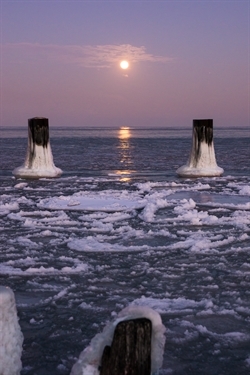
Flickr CC/Don Harder
If you’re like me, you may have woken up the last couple mornings to get ready for your day and been a bit confused about how to deal with the weather. Do I bundle up in my down winter coat or something more appropriate for springtime 60s? Do I bring an umbrella? Rain boots? Sartorial indecision aside, what exactly does it mean for the Chicago region that we had below freezing temperatures last week, snow a few days ago (finally, after a record-setting 335 days!), freezing rain over the weekend, a record-setting 60-degree, rainy day today, and freezing temperatures later this week? Other than more evidence of the unpredictability of climate change and the difficulty of planning for it, this strange weather really highlights the interconnectedness of all our water resources.
On the one hand, the rain can be a good thing. As you may remember, northeastern Illinois has been going through a pretty significant drought (read the ongoing Experiencing Drought series to see how communities have been handling it), and even though the summer’s over, the drought and its impacts are not. As recently as last week, our entire region was still considered to be in moderate drought and those in the northwest counties of McHenry and DeKalb were still in severe drought. This week’s snow and rain go toward replenishing our lakes, streams, soils and aquifers with much needed moisture. But we’re not in the clear yet. This precipitation helps, but, as reported by the Illinois State Water Survey, we still have a huge precipitation deficit from 2012 to work our way out of. And national outlooks predict that drought will continue to have a negative effect on crop production for next year.

Flickr CC/Brian Koprowski
The unseasonable warmth and wetness unfortunately has its downsides, too. The quick temperature changes may be confusing for us to get used to, but they’re also hard on our infrastructure. Only a few days ago, freezing temperatures meant frozen ground, and now predictions of heavy rainstorms today mean rain events that are already difficult for our antiquated stormwater systems to handle will be further complicated by not being able to infiltrate into the ground. The freezing rain on Sunday had everyone out quickly with salt to melt icy roads and sidewalks, but the shift to warmer temperatures and rain meant all that salt was quickly flushed into local waterways, negatively impacting those waterways and shallow groundwater aquifers. Furthermore, this lack of snow does not bode well for drought conditions for next summer. One contributor to last year’s drought was the lack of snow last winter. The lack of ice cover on lakes, including Lake Michigan could mean the continuation of low lake levels due to the increased amount of time the lake is left unprotected from evaporation. Low lake levels affect everything from shipping to recreation.
So, what does this all mean for planning in the near and medium terms? How do we make sense of this roller coaster weather, and more importantly, how do we prepare for it going forward? Recognizing that business as usual won’t be enough to accommodate these shifting weather patterns is the first step. The year 2012 was an outlier for many extreme weather categories, from drought to precipitation to temperature. According to the National Oceanic and Atmospheric Administration’s State of the Climate, the average annual temperature for the continental U.S. was “3.2°F above the 20th century average, and was the warmest year in the 1895-2012 period of record for the nation.” These shifts and more are detailed in the draft of the National Climate Assessment and Development Advisory Committee climate assessment report (if you don’t have time to read it, I’d recommend the executive summary or WBEZ’s overview). The bottom line is that there’s no more time to waste waiting for things to “get back to normal.”

Flickr CC/Jonathan Robson
Across the country, cities are learning the importance of creating and maintaining resilient infrastructure. This means not only repairing and replacing decade’s old infrastructure and implementing new technologies, but it also means planning to use what we have more efficiently and take advantage of natural systems rather than engineering them out of existence. It means:
- implementing water conservation and efficiency policies not as a feel-good “green” initiative, but for real financial savings from capital expansion delay;
- municipalities and utilities using technology and planning to keep infrastructure responsive and resilient;
- purposeful funding of infrastructure programs to put funds in places that will have the best impact and to ensure that utilities have enough money to pay for the service their customers expect;
- understanding how stormwater, wastewater and water supply are all connected and need to be thought of using an integrated resource planning framework;
- advancing policies to ensure innovative practices, such as strategic water reuse, are not only allowed, but encouraged;
- streamlining of government structures and processes to improve efficiencies and communication; and,
- perhaps most importantly, working together rather than competitively at all scales. From the individual community and neighborhood level, as with our green infrastructure and stormwater management work in Blue Island and Logan Square, to regional collaboration, as with our work with our work on water supply management with the Northwest Water Planning Alliance and the newly convened regional group working on state water policy coordination.
This isn’t even all that can be done to prepare for this new normal, but this is a sample of what MPC is starting with in 2013. Stay tuned for the policies, reports, plans, and events we have coming this year and follow our progress by subscribing to our Re-Connection e-newsletter, reading our The Connector and What Our Water’s Worth blogs, and following me on Twitter @AbbyMPC.